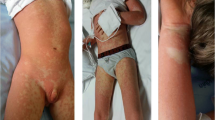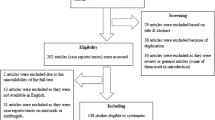Abstract
Drug reaction with eosinophilia and systemic symptoms (DRESS), also known as drug-induced hypersensitivity syndrome (DIHS), is a severe drug-induced hypersensitivity reaction with 10% mortality. To date, there is insufficient evidence regarding the association between DRESS/DIHS and serum levels of vancomycin (VCM). Here, we report the case of a 46-year-old woman undergoing peritoneal dialysis who developed VCM-induced DRESS/DIHS. She was hospitalized for peritonitis with abdominal pain and treated with VCM. On day 10 of hospitalization, her abdominal symptoms improved; however, fever, skin rash, lymphadenopathy, eosinophilia, atypical lymphocytes, and liver and renal dysfunction developed. Based on the clinical course and laboratory findings, we diagnosed the patient with DRESS/DIHS due to VCM. Since her serum VCM concentration was high at 39.8 μg/mL, hemodialysis (HD) was performed to remove VCM, which caused her symptoms to improve. However, serum levels of VCM rebounded and the same symptoms recurred. Therefore, we re-performed HD; no further relapse occurred. This clinical course showed that increased serum VCM levels were associated with DRESS/DIHS onset and severity, suggesting that it is a blood level-dependent disease and that removal of VCM by HD is a potential therapeutic option.


Similar content being viewed by others
Availability of data and materials
The datasets used and/or analyzed during the current study are available from the corresponding author upon reasonable request.
References
Bocquet H, Bagot M, Roujeau JC. Drug-induced pseudolymphoma and drug hypersensitivity syndrome (Drug Rash with Eosinophilia and Systemic Symptoms: DRESS). Semin Cutan Med Surg. 1996;15:250–7. https://doi.org/10.1016/s1085-5629(96)80038-1.
Cacoub P, Musette P, Descamps V, Meyer O, Speirs C, Finzi L, et al. The DRESS syndrome: a literature review. Am J Med. 2011;124:588–97. https://doi.org/10.1016/j.amjmed.2011.01.017.
Miyagawa F, Asada H. Current perspective regarding the immunopathogenesis of drug-induced hypersensitivity syndrome/drug reaction with eosinophilia and systemic symptoms (DIHS/DRESS). Int J Mol Sci. 2021;22:2417. https://doi.org/10.3390/ijms22042147.
Hama N, Abe R, Gibson A, Phillips EJ. Drug-induced hypersensitivity syndrome (DIHS)/drug reaction with eosinophilia and systemic symptoms (DRESS): clinical features and pathogenesis. J Allergy Clin Immunol Pract. 2022;10:1155-1167.e5. https://doi.org/10.1016/j.jaip.2022.02.004.
Ng CY, Yeh YT, Wang CW, Hung SI, Yang CH, Chang YC, et al. Impact of the HLA-B(*)58:01 allele and renal impairment on allopurinol-induced cutaneous adverse reactions. J Invest Dermatol. 2016;136:1373–81. https://doi.org/10.1016/j.jid.2016.02.808.
Chung WH, Chang WC, Lee YS, Wu YY, Yang CH, Ho HC, et al. Genetic variants associated with phenytoin-related severe cutaneous adverse reactions. JAMA. 2014;312:525–34. https://doi.org/10.1001/jama.2014.7859.
Maubec E, Wolkenstein P, Loriot MA, Wechsler J, Mulot C, Beaune P, et al. Minocycline-induced DRESS: evidence for accumulation of the culprit drug. Dermatology. 2008;216:200–4. https://doi.org/10.1159/000112926.
Blumenthal KG, Alvarez-Arango S, Fu X, Kroshinsky D, Choi H, Phillips E, et al. Risk factors for vancomycin drug reaction with eosinophilia and systemic symptoms syndrome. JAMA Dermatol. 2022;158:1449–53. https://doi.org/10.1001/jamadermatol.2022.3541.
Kardaun SH, Sekula P, Valeyrie-Allanore L, Liss Y, Chu CY, Creamer D, et al. Drug reaction with eosinophilia and systemic symptoms (DRESS): an original multisystem adverse drug reaction. Results from the prospective RegiSCAR study. Br J Dermatol. 2013;169:1071–80. https://doi.org/10.1111/bjd.12501.
Sharifzadeh S, Mohammadpour AH, Tavanaee A, Elyasi S. Antibacterial antibiotic-induced drug reaction with eosinophilia and systemic symptoms (DRESS) syndrome: a literature review. Eur J Clin Pharmacol. 2021;77:275–89. https://doi.org/10.1007/s00228-020-03005-9.
Pichler WJ, Tilch J. The lymphocyte transformation test in the diagnosis of drug hypersensitivity. Allergy. 2004;59:809–20. https://doi.org/10.1111/j.1398-9995.2004.00547.x.
Kumar T, Teo I, McCormick BB. Systemic toxicity of intraperitoneal vancomycin. Case Rep Nephrol. 2016;2016:3968690. https://doi.org/10.1155/2016/3968690.
Melis D, Carbone F, Minopoli G, La Rocca C, Perna F, De Rosa V, et al. Cutting edge: increased autoimmunity risk in glycogen storage disease type 1b Is associated with a reduced engagement of glycolysis in T cells and an impaired regulatory T cell function. J Immunol. 2017;198:3803–8. https://doi.org/10.1177/08968608221080586.
Kishnani PS, Austin SL, Abdenur JE, Arn P, Bali DS, Boney A, et al. Diagnosis and management of glycogen storage disease type I: a practice guideline of the American College of Medical Genetics and Genomics. Genet Med. 2014;16: e1. https://doi.org/10.1038/gim.2014.128.
Kirchhof MG, Wong A, Dutz JP. Cyclosporine treatment of drug-induced hypersensitivity syndrome. JAMA Dermatol. 2016;152:1254–7. https://doi.org/10.1001/jamadermatol.2016.2220.
Madigan LM, Fox LP. Vancomycin-associated drug-induced hypersensitivity syndrome. J Am Acad Dermatol. 2019;81:123–8. https://doi.org/10.1016/j.jaad.2019.02.002.
Higuchi M, Agatsuma T, Iizima M, Yamazaki Y, Saita T, Ichikawa T, et al. A case of drug-induced hypersensitivity syndrome with multiple organ involvement treated with plasma exchange. Ther Apher Dial. 2005;9:412–6. https://doi.org/10.1111/j.1744-9987.2005.00320.x.
Oiwa H, Yoshida S, Okada H, Yasunishi M, Kamidani R, Suzuki K, et al. Atypical drug-induced hypersensitivity syndrome with multiple organ failure rescued by combined acute blood purification therapy: a case report. Int J Emerg Med. 2023;16:33. https://doi.org/10.1186/s12245-023-00511-2.
Lam E, Lien Y, Kraft W, Kraft W, Piraino B, Vozmediano V, et al. Vancomycin in peritoneal dialysis: clinical pharmacology considerations in therapy. Perit Dial Int. 2020;40:384–93. https://doi.org/10.1177/0896860819889774.
Böhler J, Reetze-Bonorden P, Keller E, Kramer A, Schollmeyer PJ. Rebound of plasma vancomycin levels after haemodialysis with highly permeable membranes. Eur J Clin Pharmacol. 1992;42:635–9. https://doi.org/10.1007/BF00265928.
Pollard TA, Lampasona V, Akkerman S, Tom K, Hooks MA, Mullins RE, et al. Vancomycin redistribution: dosing recommendations following high-flux hemodialysis. Kidney Int. 1994;45:232–7. https://doi.org/10.1038/ki.1994.28.
Waldman RA, Grant-Kels JM. Thinking outside the box: is there a role for extracorporeal blood purification in DRESS syndrome complicated by acute kidney injury? Clin Dermatol. 2020;38:580–3. https://doi.org/10.1016/j.clindermatol.2020.04.014.
Rybak MJ. The pharmacokinetic and pharmacodynamic properties of vancomycin. Clin Infect Dis. 2006;42(Suppl 1):S35–9. https://doi.org/10.1086/491712.
Li PD, Chow KM, Cho Y, Fan S, Figueiredo AE, Harris T, et al. ISPD peritonitis guideline recommendations: 2022 update on prevention and treatment. Perit Dial Int. 2022;42:110–53. https://doi.org/10.1177/08968608221080586.
Acknowledgements
We would like to thank the medical staff for their skillful care while treating this patient and Editage (www.editage.com) for English language editing.
Funding
The authors have no financial sources to declare.
Author information
Authors and Affiliations
Contributions
RM, TN and SY wrote the manuscript. RM, TN, KU, NY, EK, KM, TY, TK, SY, and KH took clinical care of the patient. JY and KH supervised the manuscript. All authors have read and approved the final manuscript.
Corresponding author
Ethics declarations
Conflict of interest
All the authors have declared no competing interest.
Human and/or animal participants
This article does not contain any studies with human participants or animals performed by any of the authors.
Informed consent
Informed consent was obtained from the patient for publication of this case report and all accompanying images.
Additional information
Publisher's Note
Springer Nature remains neutral with regard to jurisdictional claims in published maps and institutional affiliations.
About this article
Cite this article
Mitsuno, R., Nakayama, T., Uchiyama, K. et al. Hemodialysis treatment of vancomycin-induced drug reaction with eosinophilia and systemic symptoms/drug-induced hypersensitivity syndrome in a patient undergoing peritoneal dialysis. CEN Case Rep (2024). https://doi.org/10.1007/s13730-023-00847-x
Received:
Accepted:
Published:
DOI: https://doi.org/10.1007/s13730-023-00847-x




